Details
In a neutrally stable atmosphere the vertical wind profile u(z) at elevation z in the first 50-80 m above the ground has a logarithmic shape. Specifically κ u(z)/u*=log(z/z0) where κ=0.4 is the von Karman constant, u* is the friction velocity and z0 is the surface roughness. If τ is the surface stress exerted by the wind on the ground and ρ is air density then the friction velocity is u*=(τ/ρ)1/2. Application of the logarithmic profile requires z/z0>>1.
For surfaces with significant canopy height, e.g. tall tress, the form of the logarithmic profile must be modified for canopy effects. The modification is κ u(z)/u*=log[(Z-d)/z0] where Z is height above the substrate surface and d is the so-called zero plane displacement. For many naturally occurring surfaces the relationship between the canopy height hc and the zero plane displacement d takes the simple form d/hc≈2/3. The zero plane displacement values in the accompanying data table are expressed in the dimensionless form d/hc.
For moderate wind speeds friction velocities are on the order of about 0.5 m/s. For strong winds friction velocities are on the order of 1.0 m/s. Friction velocity can be measured directly but it is usually inferred by making a wind speed measurement at a known height with an anemometer.
In a stable atmosphere wind speeds increase faster with altitude than predicted by the logarithmic profile. In an unstable environment the reverse happens. That is wind speeds increase slower with altitude than predicted by the logarithmic profile. The magnitude of these wind speed variations can be predicted using Monin-Obukhov similarity theory. This requires the introduction of an additional scale length, namely the Obukhov stability length L. In a stable atmosphere L>0 and the wind profile is approximately κ u(z)/u*=log(z/z0)+4.8z/L. In an unstable environment L<0 and an approximate form of the wind profile is κ u(z)/u*=log(z/z0)-3log(ψ(z)/ψ(z0)) where ψ(z)=1+(1+3.6|z/L|)1/2. If L becomes very large in a positive or negative sense then the Monin-Obukov profile reduces to the wind profile in a neutral atmosphere.
The Obukhov length L is defined via L=-u*3/(κ (g/Tv)F) where u* is the friction velocity, κ=0.4 is the von Karman constant, g is the acceleration due to gravity, Tv is the absolute virtual temperature and F is the kinematic surface heat flux. All the parameters in the equation defining the Obukhov length are positive with the exception of the kinematic surface heat flux F. Under stable conditions F<0 which makes L>0. Under unstable conditions F>0 and L<0. The Obukhov length can be interpreted as the height in a stable atmosphere where the production of turbulence by shear effects exceeds buoyant consumption. Stable conditions often occur at night. Unstable conditions often occur in daylight hours during time periods with high solar illumination.
Atmospheric stability can be determined with the aid of the Pasquill meteorological stability estimation technique. The near-ground atmosphere is divided into 6 classes (A-F) and class determination is based upon observing the amount of incoming solar radiation in daylight (or cloud cover at night) and wind speed at a height of 11 m. Pasquill classes A, B and C occur in daylight hours and correspond to the most unstable and turbulent conditions. Class D typically corresponds to a neutral atmosphere which occurs near dawn. Classes E and F correspond to the most stable environments (typically at night) and least turbulent. Knowledge of the Pasquill stability class and surface roughness length z0 can be used to estimate the Obukhov length L via the regression procedure L-1=a+b log10(z0) where a and b are coefficients that depend on the Pasquill stability class.
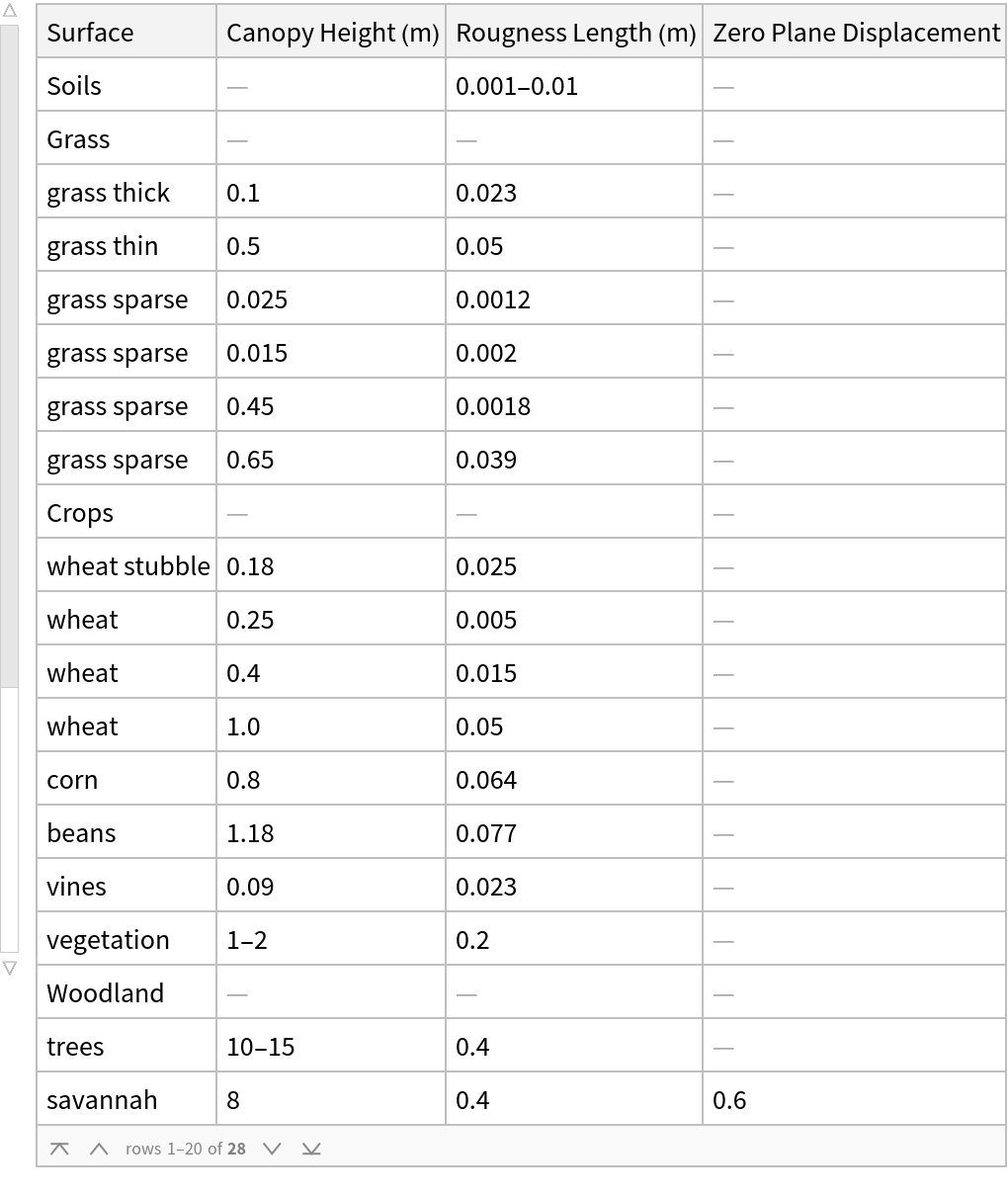
![Clear[hc, all, missing, value, reformat, pairs];
hc = Normal@data[All, 2]; z0 = Normal@data[All, 3];
all = Transpose[{hc, z0}];
missing = Select[%, #[[1]] == Missing[] &];
value = Flatten[Complement[all, missing]];
reformat = If[NumberQ[#] == True, #, GeometricMean@ToExpression[StringSplit[#, "-"]] ] &;
pairs = Partition[Map[reformat, value], 2]; {hc, z0} = Transpose[pairs];
ListPlot[Transpose[{hc, z0/hc}], Sequence[
PlotRange -> {-0.025, Max[z0/hc] + 0.1}, Axes -> False, Frame -> True, FrameLabel -> {"canopy height", "surface rougness/canopy height"}, ImageSize -> 600, Epilog -> {{
Dashing[0.01],
Line[{{0, 0.02}, {35, 0.02}}]}, {
Dashing[0.01],
Line[{{0, 0.2}, {35, 0.2}}]}}, BaseStyle -> {FontSize -> 14}]]](https://www.wolframcloud.com/obj/resourcesystem/images/036/036318b9-fda4-450d-9987-af9c24888476/6c05974f071b4b14.png)
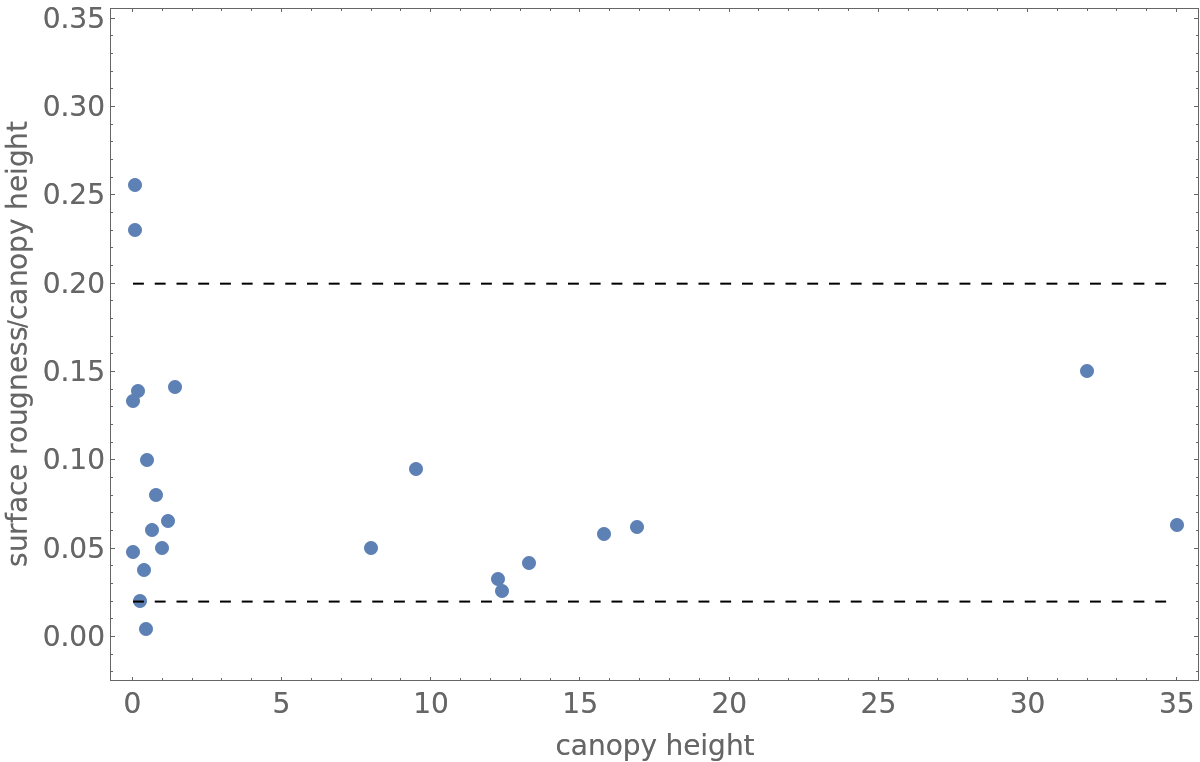
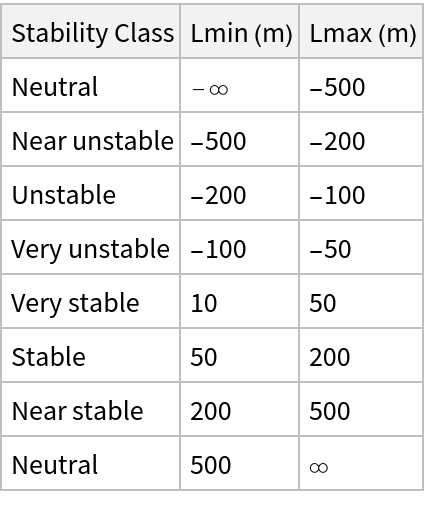

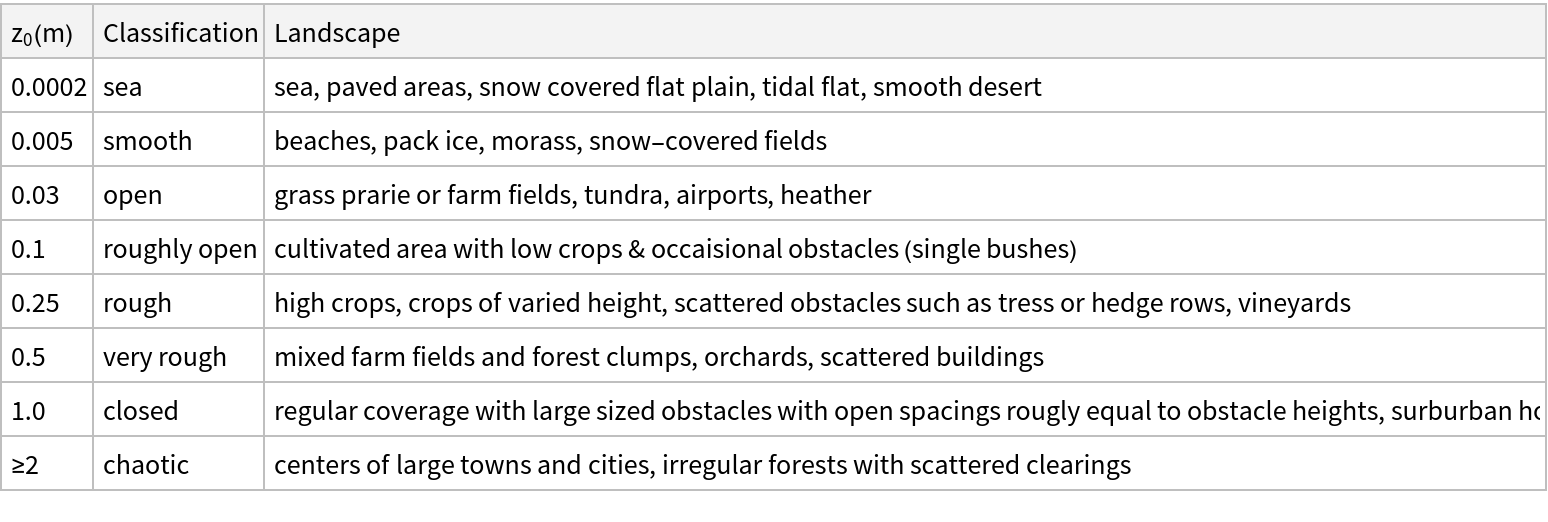
![ResourceData[\!\(\*
TagBox["\"\<Parameters for Near Ground Wind Speed Estimation\>\"",
#& ,
BoxID -> "ResourceTag-Parameters for Near Ground Wind Speed Estimation-Input",
AutoDelete->True]\), "PasquillDavenportWieringaTable"]](https://www.wolframcloud.com/obj/resourcesystem/images/036/036318b9-fda4-450d-9987-af9c24888476/39cbe5c9737b0e55.png)
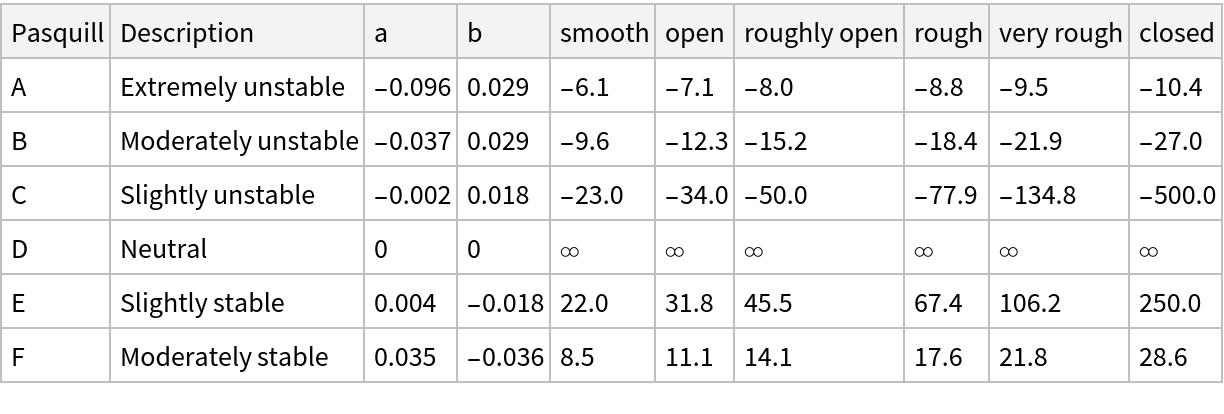
![data1 = ResourceData[\!\(\*
TagBox["\"\<Parameters for Near Ground Wind Speed Estimation\>\"",
#& ,
BoxID -> "ResourceTag-Parameters for Near Ground Wind Speed Estimation-Input",
AutoDelete->True]\), "StabilityObukhovTable"];
label = Take[Normal[data1[All, 1]], {5, 7}];
lmin = Take[Normal[data1[All, 2]], {5, 7}]; lmax = Take[Normal[data1[All, 3]], {5, 7}];
lObukhov = N@Map[GeometricMean, Transpose[{lmin, lmax}]];
Table[{label[[i]], lObukhov[[i]]}, {i, 1, 3}];
TableForm[%, TableHeadings -> {None, {"Stability", "(Lmin*Lmax\!\(\*SuperscriptBox[\()\), \(1/2\)]\)"}}]](https://www.wolframcloud.com/obj/resourcesystem/images/036/036318b9-fda4-450d-9987-af9c24888476/2d9eaa01ff88697e.png)

![With[{ustar = 0.25, z0 = 0.1, \[Kappa] = 0.4},
profiles = Table[Table[{ustar/\[Kappa] (Log[z/z0] + 4.8 z/lObukhov[[i]]), z}, {z, z0, 80, 0.1}], {i, 1, 3}]];
ListLinePlot[profiles, Sequence[
PlotLegends -> label, AxesLabel -> {"u (m/s)", "z (m)"}]]](https://www.wolframcloud.com/obj/resourcesystem/images/036/036318b9-fda4-450d-9987-af9c24888476/62c2cd4d1df3761a.png)
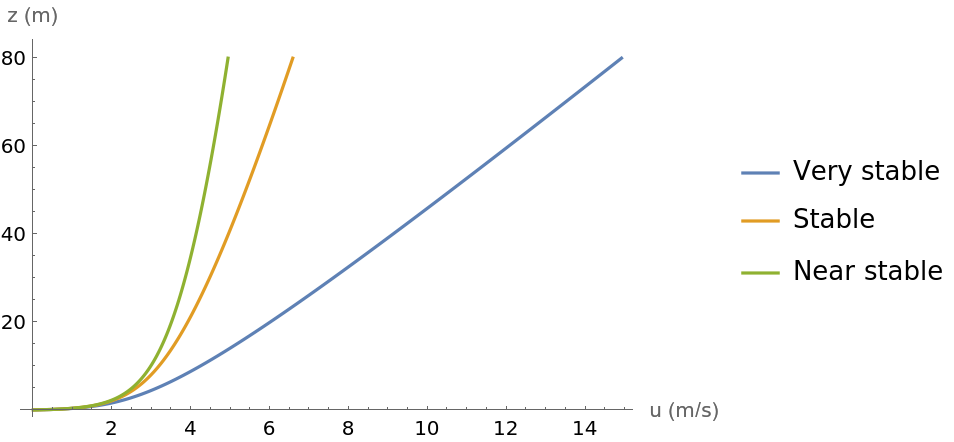
![With[{ustar = 0.5, \[Kappa] = 0.4, z0 = 0.1, LStable = 316.0, \[Gamma]m = 3.6, LUnstable = -71},
profileNeutral = Table[{ustar/\[Kappa] Log[z/z0], z}, {z, z0, 80, 0.1}];
profileStable = Table[{ustar/\[Kappa] (Log[z/z0] + 4.8 z/LStable), z}, {z, z0, 80, 0.1}];
profileUntable = Table[{ustar/\[Kappa] (Log[z/z0] - 3 Log[(1 + (1 + \[Gamma]m*Abs[z/LUnstable])^(1/2))/(
1 + (1 + \[Gamma]m*Abs[z0/LUnstable])^(1/2))]), z}, {z, z0, 80, 0.1}];
ListLinePlot[{profileNeutral, profileStable, profileUntable}, Sequence[
PlotLegends -> {"Neutral", "Near stable", "Very unstable"}, AxesLabel -> {"u (m/s)", "z (m)"}]]
]](https://www.wolframcloud.com/obj/resourcesystem/images/036/036318b9-fda4-450d-9987-af9c24888476/5850fbf41513f88d.png)
